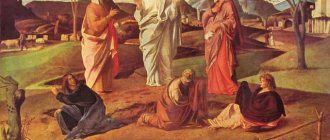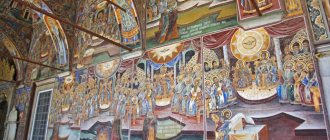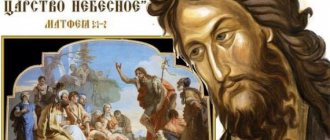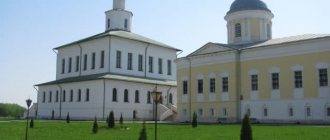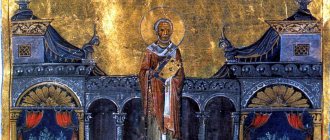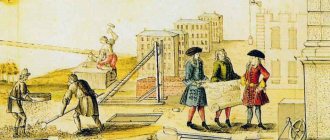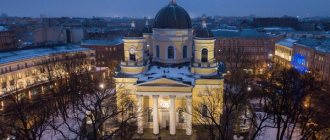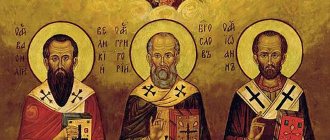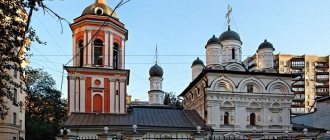The memory of our three holy fathers: Basil the Great, Gregory the Theologian and John Chrysostom takes place on February 12 (January 30, old style). The three great saints are revered as universal teachers who left us a great theological heritage.
Ecumenical teachers: Basil the Great, Gregory the Theologian and John Chrysostom
Saints Basil the Great, Gregory the Theologian and John Chrysostom
The teachers of the Church Vasily, Gregory and John, who lived in the 4th-5th centuries, became great successors of the chief apostolic educational field, for which each of them received from the people a name-title that commemorates their feat. Vasily - the Great, pillar, support of faith. Are there many such greats? One hand is enough to count. Gregory is a theologian who surpassed all Hellenic teaching, a poet, a thinker who became a lamp of God’s word. John - Chrysostom, a brilliant orator, ardent preacher, wise mentor, impartial denouncer of all untruths.
Oh, how the Church needed, and still needs, wise, educated and talented educators, those who can, with word, knowledge, and faith, resist pagan superstition and Vetism, expose lies and all kinds of heresy, dispel doubts and delusions.
And then the Church, which had just gained freedom, was in dire need of educators, because... Without teaching and educating the people, it was impossible to cleanse themselves of internal paganism, which was deeply rooted in the consciousness and affected through and through the environment of people's everyday life. Idols still stood, fortune tellers sat on the streets, all sorts of sorcerers and sorcerers confused the people, and philosophers argued with each other until they were hoarse, wandering in search of mental truth.
Useful materials
Why isn’t our time?.. And then, as now, who is profiting from the state of human darkness and doubts, fears and delusions. And they, the enlighteners - Vasily, Gregory and John, each in their own way, resisted darkness, heresies, chaos in thoughts and deeds. They stood up for people from evil, for which they suffered slander, reproaches, envy, slander, were persecuted, condemned, and imprisoned. However, truth conquers everything:
“And the light shines in the darkness, and the darkness did not overcome it” (John 1:5).
Saint John Chrysostom
Memorial Day November 13 (November 26 old style).
John Chrysostom was born in 347. His father died shortly after the birth of his son, so the responsibility for raising him fell entirely on John’s mother, Anfusa. The young man studied rhetoric from the greatest teacher of the late antique era - Libanius. The teacher valued John so highly for his impressive successes that in the last years of his life, when asked who he would entrust the school to, Libanius replied: “Chrysostom, if Christians had not kidnapped him” (Libanius was alien to the Christian faith and therefore was deeply upset the fact that many of his students, including John Chrysostom, converted to Christianity).
After completing his studies, the Saint spent some time practicing law in Antioch. After the death of his mother, Chrysostom accepted monasticism, which he called “true philosophy,” and retired to the desert for 4 years.
Saint John Chrysostom
In 381 he returned to Antioch and was ordained a deacon and then a presbyter (386). During his priestly activity, the Saint paid special attention to the interpretation of Holy Scripture and preaching. His reputation soon spread beyond Antioch, and at the end of 397 he was summoned to Constantinople, where the Council of Bishops elected him Archbishop of Constantinople (February 26, 398).
His main goal was the reorganization of the Church, since Chrysostom believed that the moral revival of society should be preceded by the spiritual cleansing of the clergy and nobility.
His sermons exposed the licentious morals of the imperial court and society as a whole, calling for the need to return to the principles of Christian life. The saint did not hesitate to speak out against the Empress Eudoxia, which is why he was exiled twice.
John Chrysostom died on September 14, 407 at the age of 60, during his second exile, on his way to Pitsunda (Abkhazia).
John Chrysostom is recognized as the greatest church writer. His works are impressive in their volume and theological depth.
Brief biography
St. Basil the Great
Iconography: Basil the Great, saint Dates: XVI century. Third quarter of the 16th century. Icon painting school or art center: Tver. Origin: From the church of the village of Georgievskoye, Bezhetsky district, Kalinin region. Material: Wood, gesso, tempera. Dimensions of the icon: height 100 cm, width 32 cm Life-size image of Basil the Great. With both hands he supports an unfolded scroll with text. The saint is wearing a white cross veil and a white omophorion and cassock. KP 0257. © Central Museum of Ancient Russian Culture and Art named after Andrei Rublev
Basil the Great was a scientist, monk, and manager; he lived a very short life from 330 to 379. By our standards, he died still quite a young man, since he did not live to be 50 years old, but at the same time he left a memory of himself for centuries, giving the Church treasures of his works, instructions, rules, conversations, interpretations, and with his very moral life he showed an example of active service people and God.
The high significance of the saint’s activities cannot be overestimated, especially considering the state of the Church at that time. The church was just beginning to be built then, freed from persecution. Communities existed separately, there was no uniformity of service, dogmas were just being formulated, and the pagan environment still dominated. At the same time, diseases of error and heresy have already appeared in the church environment.
Basil the Great paved a bridge for the human mind to move from ancient consciousness and the philosophical search for truth to the Christian worldview, Christian morality and Christian foundations of social life, establishing faith and piety around. He contributed to the development of Orthodox dogma, to the definition of the concepts of “essence” and “hypostasis,” which served as a basis for the fight against Arianism and became the basis for the formulation of the dogma of the Holy Trinity.
The exegetical Conversations of the saint on the Sixth Day are widely known, providing the theological basis for the development of the natural sciences. In addition to literary activity and theology, Vasily did a lot for the organization of the Church organization, streamlining its internal structure, and also worked to formalize the service, drawing up the rite of the Divine Liturgy. The people remembered the saint for his charitable and patronage activities.
Basil the Great did a lot for the Church; it is necessary to separately note which family this man came from, then the strength of his faith and the source of his active energy will become clear. Of particular importance in modern conditions of the weakening of traditional values is the need to unite and strengthen the Christian family, and the life of Basil the Great shows church people the power of the family root, the power of prayers for loved ones and their loved ones.
The family is a support for the human soul, a breeding ground for the cultivation of faith, a gift-bearer for passing on from generation to generation the good experience of life in Christ. Such a family were those close to Basil the Great, who taught him holiness. The saint's paternal grandmother, Macrina (the eldest), was canonized by the Church (May 30 / June 12). She was a pupil of St. Gregory the Wonderworker of Neocaesarea (†c. 270), who is considered the author of the most successful exposition of the Creed, which he introduced into the Neocaesarea community in early times.
Interesting fact
Macrina, who learned the dogmas of faith from Gregory, passed them on to her grandson Vasily, instructing him from an early age in the love of God and “pious teachings,” and most importantly, she taught him to always thank the Lord for everything.
Saint Basil's mother Saint Emilia (January 1 / January 14) was from Caesarea and became an orphan early; her parents were martyrs for the faith under the Emperor Licinius. Although the beautiful Emilia wanted to devote herself to God, in order not to fall a victim of violence, the orphan married an educated and kind young lawyer Vasily (senior), the son of the pious Macrina.
Holy family of St. Basil the Great. Icon 1999
Interesting fact
The parents of the future saint, Basil and Emilia, had ten children, five of whom became saints: Basil the Great, Bishop of Caesarea of Cappadocia; Gregory, Bishop of Nyssa (January 10/January 23); Peter, Bishop of Sebaste (January 9/January 22); Venerable Macrina the Younger (July 19/August 1) and Blessed Theosevia, otherwise Theozva the Deaconess (January 10/January 23).
This is the good fruit brought by the Christian marriage of Vasily and Emilia and the good upbringing in the family through the pious life of the parents and the religious instructions of the grandmother-confessor, who suffered a lot in life for the faith of Christ, but never grumbled, but firmly believed in the providence of God and did not forget for everything Thank him.
The family cared about the upbringing and education of children. So Basil, having received sufficient education at home from his father, a highly educated lawyer and teacher of rhetoric, was sent to Caesarea Cappadocia to the best school, and then to the center of classical education - in Athens. While still at the Caesarea school, Vasily became friends with a fellow student, Gregory. Vasily and Grigory retained this student friendship for the rest of their lives, becoming close to each other like brothers. In the future, Gregory will also become a saint, and the Church will call him the Theologian.
After completing his secular studies, Vasily went not to the capital, but to the Egyptian desert to the hermit monks to learn Divine wisdom from them. He's writing:
“I was amazed at their moderation in food, their endurance in work, I was amazed at their deep prayerful mood, I was amazed at how they successfully fight sleep, how their thoughts are always sublime and free, despite hunger and thirst, the cold and scanty clothing... Living as if their body did not belong to them, they actually showed what it means to live in this world with the thought of another world and to have your own fatherland in heaven... I prayed that I too, as far as my strength would allow, could become an imitator of these people "
But soon Vasily had to leave the desert to actively defend Orthodoxy from the Arian heresy. Already in the rank of Bishop of Caesarea, he fearlessly fought against the heresiarchs, who possessed both ecclesiastical and secular power. The saint did not lose courage even before the Arian Emperor Valens, even under the threat of death he stood in the faith of Christ, thus responding to the insane force:
“If you take away my property, you will not enrich yourself, and you will not make me a beggar. I believe that you do not need these old clothes of mine and several books in which all my wealth lies. There is no exile for me, because I am not bound by place and the place where I live now is not mine, and wherever they send me will be mine... And what can torment do to me? - I am so weak that only the first blow will be sensitive to me. Death for me is a blessing: it will sooner lead me to God, for whom I live and work, and to whom I have long been striving... In everything else we are meek, more humble than anyone, and not only before such power, but before everyone, because This is what the law has prescribed for us. But when the matter is about God and they dare to rebel against Him, then we, blaming everything else for nothing, look only at Him alone, then fire, sword, beasts and iron tormenting the body will rather be a pleasure for us than frighten us.”
Power retreated before Truth. Vasily devoted his entire life to serving the Church of Christ, strengthening, protecting, enlightening and improving it. In all the sorrowful circumstances of his life, he thanked the Lord for everything.
This is what Basil the Great, the great shepherd who taught people to get rid of the sin of ingratitude, said:
“Nowadays many fall into the vice of evil people, not respecting what they have and wanting what they don’t have. For, not thinking about those who are lower than them, they do not express gratitude to the Benefactor for what they have, but on the contrary, when compared with what and who is higher than them, they calculate what they lack and, not having what belongs to others, they grieve and they grumble as if they have lost their property. The slave is indignant that he is not free; brought up in freedom - which is not of high origin; a nobleman complains that he is not too rich; the rich man grieves and laments that he is not the ruler of cities and nations; a military leader who does not reign; a king who does not possess all the sunflowers, but that there are still nations who have not bowed under his scepter. What emerges from all this is that the Benefactor receives no gratitude for anything.”
1
January
379
Saint Basil died in the ninth year of his episcopal ministry, having had time to deliver his farewell speech and ordain several close disciples.
His last words were: “In Your hands I commend my spirit” (Ps. 30:6). He was buried in the city of Caesarea Cappadocia (modern Kayseri, Turkey), and later the relics were taken to the west. Some of the relics and the venerable head of the saint are preserved on Mount Athos.
St. Gregory the Theologian
Icon of St. Gregory the Theologian and the Exaltation of the Cross
Gregory the Theologian, like his friend Vasily, came from a wealthy wealthy family; he was born around 330 near the city of Nazianza in Cappadocia. In this city his father, also Gregory, was a bishop and known as Saint Gregory of Nazianzen the Elder (January 1/January 14). Gregory loved his father and described him this way:
“He is meek, not angry, calm in appearance, ardent in spirit, rich in visible gifts, and even more so in hidden gifts.”
But even more, the saint loved his mother, Nonna, who was also glorified as a saint (August 5/August 18). Saint Nonna showed the church people an example of active Christian love. From the first day of family life, she became for her husband, who came from a pagan family, a lamp of faith, convincing him to accept Holy Baptism.
Gregory the Theologian in his writings wrote about the family life of his parents:
“The wife God gave to my parent was not only a collaborator for him, which is not very surprising, but also a leader. She herself, in word and deed, directed him to everything excellent. Day and night she fell before God, in fasting and with many tears she asked Him to grant salvation to her head and worked tirelessly on her husband, trying to win him in various ways.”
At the age of 45, Gregory the Elder, convinced by the light of Christian love emanating from his wife all his life, was baptized, then became a presbyter and finally took the episcopal see of the city of Nazianza. Nonna has always been a support for her husband in his chosen difficult path of serving the Church of Christ. Saint Nonna, in her marriage to Gregory the Elder, had three children: sons Gregory and Caesarius, and the eldest daughter Gorgonia, who was also glorified by the holy Church (February 23/March 8).
Saint Gorgonia, following the example of her mother, brought her husband to Christ. Gregory the Theologian highly valued the feat of a Christian sister, mother of a family, mentor in the faith of everyone around her, not with tedious edifications, but with true love, deeds of faith and piety:
“She devoted herself entirely to God. But what is especially good and worthy of respect in her is that she won over her husband to her side and had in him not an obstinate master - a good co-servant. Not only that: she made the very fruit of the body, that is, her children and grandchildren, the fruit of the spirit, for she purified the entire clan and the entire family, like a single soul, and purchased it for God... Throughout her life, she served as an example for children of all that is good, and when she was recalled from here “She left behind her will to her family as a silent instruction.”
Gregory himself received his first instructions in the faith from his mother Nonna; when he came of age, he was well educated and studied with the best philosophers and rhetoricians in Athens. During his student years, he acquired a lifelong friend, Vasily, with whom, after graduation, they retired from the secular bustle to a monastic cell, preferring asceticism, godly thinking and following Christ along the way of the cross to a brilliant career and entertainment of golden youth.
All his life Gregory loved solitude and prayer; his poetic soul was reluctant to tear itself away from the contemplation of Divine silence. But he always neglected his own interests for the sake of the common church cause, taking his mind away from prayer, Gregory went out to preach. At the insistence of his friend Vasily, he was forced to take the episcopal see in Sasima, although this was very burdensome.
And even before that, he had to help his father Gregory, Bishop of Nazianza, to understand the intricacies of the Arian false teaching that penetrated the minds, confusing not only the flock, but also the abbots. Gregory spent many years in his native Nazianza, fulfilling his pastoral duties and helping his father in his episcopal service.
Later, after the death of his parents in 374, Gregory was able to indulge in solitude and prayer for a short time, but in 379 he was again called to serve in the capital Constantinople, where with his eloquence and the burning of sincere faith he fought against the Arianism that had gripped the community. The heretics, who had triumphed on the capital's throne for 40 years, evilly persecuted Gregory, driving him out of churches with stones. Gregory had to serve in private houses.
Interesting fact
In one of the house churches, called Anastasia (Greek for “Resurrection”), in the summer of 380 he pronounces his five Words “On Theology,” which became widely known and brought him the fame of “Theologian.”
The new emperor Theodosius, unlike his predecessor Valens, supported Gregory and in 381 the Second Ecumenical Council was convened, at which Gregory gave an exposition of the dogma of the Trinity. The Council condemned heresy; after the Council, Gregory, lenient to all intrigues against him and intrigues, so as not to give rise to division of the flock, left the capital's see and again retired to his Nazianza, where he devoted the rest of his life to literary activity.
Gregory died on January 25, old style, 389. In 950, his relics were transported to Constantinople, and then in 1204 they were taken to Rome. Under Pope John Paul II in 2004. the relics of Gregory the Theologian were returned to the Church of Constantinople along with the relics of John Chrysostom.
St. John Chrysostom
St. John Chrysostom and the Nativity of Christ
John Chrysostom (c. 347 - 407), the youngest of the three saints, was from Antioch and grew up, as they would say now, in a single-parent family. The father of John Secundus, a man of high rank, died early, and his son was raised by his mother Anfusa alone. Left a widow at the age of twenty, Anfusa lived an ascetic life, devoting herself entirely to raising her children in the faith of Christ.
Despite the difficulties of a widow's life, John's mother gave him an excellent education. The path of a successful lawyer with a high position in society opened before him. However, John, of all sciences, leaned more and more towards the study of the Holy Scriptures and the writings of the holy fathers. The educated young man was noticed by Bishop Meletius of Antioch, from him John received holy Baptism and was soon appointed a reader at the department.
After the death of his beloved mother, John went to asceticism in the life of a hermit and returned from the desert only in 380. At the same time, at the insistence of Meletius, he accepted ordination to the rank of deacon and began to fulfill his obedience in social service, i.e. care for the poor, sick and disadvantaged. John performed this obedience not only out of duty, but also at the personal call of his merciful soul. In 386 he was ordained a presbyter, and from that time his fame as an ardent preacher and brilliant speaker began to grow.
For twelve years, people from all over Antioch flocked almost daily to listen to the word of John, which was imprinted in gold on their hearts. The people revered their shepherd for his sincere service and fiery words, considering him worthy of the episcopal see, but John shirked the rank. Continuing to fulfill his pastoral duties, John at this time wrote one of the great theological works, “Six Words on the Priesthood,” as well as his other works - many interpretations of the texts of the Holy Scriptures, many conversations on biblical topics, moral teachings, festive and laudatory words.
Although the Antiochians did not want to let John go, Emperor Arcadius himself wanted to elevate the educated and beloved priest to the See of Constantinople. In 397 John ascended the patriarchal throne, remaining essentially a modest and loving shepherd. In the capital, John continued to intercede for the disadvantaged, denouncing the stinginess of the rich, the luxury of the court, and at the same time disregard for the Christian duty to share and help those in need.
He himself extremely limited expenses for the patriarchal maintenance, directing all funds to help the poor. He maintained hospitals and almshouses and fed thousands of beggars and pilgrims every day. At the same time, in his sermons he impartially denounced irrepressible luxury, immodesty and licentious morals, which irritated the nobility.
Empress Eudoxia stood at the head of the envious and slanderers of the Patriarch of Constantinople, beloved by believers. She led the pressure on the patriarch, encouraging, accepting and spreading all sorts of slanderous intrigues and attacks on him. In the end, the saint was deposed and sent into exile. The subsequent earthquake and popular unrest frightened the authorities and forced them to cancel the verdict.
However, after some time, the queen’s hatred found a new reason for punishment and, with the help of intrigue, a new sentence was passed - the Patriarch Chrysostom was taken into custody on Easter Day in 404 right during the service. Saint John was exiled first to Lesser Armenia, and then even further along the Black Sea coast to Pitiunt (Pitsunda, in Abkhazia).
14
September
407
On the way, exhausted by the transition, the already unwell Saint John died in Comana.
In 438, the relics of John Chrysostom were returned to Constantinople under Theodosius II, who asked the saint for forgiveness for his mother and during a solemn service in the cathedral church of the Holy Apostles, those standing at the shrine with the relics saw the patriarch raise his right hand and say “Peace to all.” !
Saint Gregory the Theologian
Memorial Day January 25 (February 7, old style).
Saint Gregory was born in 329 in Arianza, near the city of Nazianza in Cappadocia. He received a Christian education from his father Gregory, Bishop of Nazianza. The saint studied in the most famous spiritual centers of that time - Caesarea, Alexandria and Athens, where he was a classmate of Basil the Great.
After his studies, the Saint returned to Nazians and at the age of 30, having received baptism, went to the desert, where he became a monk.
Soon Gregory's father, who at that time was already in old age, asks him for help in the pastoral field. And upon his return, at the request of Christians, he was ordained a presbyter. Later, Basil the Great, being the bishop of Caesarea, ordained him bishop, against the will of Gregory himself.
Saint Gregory the Theologian
After the death of his father, the Saint decides to return to solitude, but since at that time he was already known for his virtue, wisdom and conscientiousness, the Christians of Constantinople call on him to join the fight against Arianism, which tormented the Church with its heretical false teachings.
Having agreed, Gregory goes to the capital, where he finds refuge in a small temple consecrated in honor of “Anastasi” (Resurrection), as a sign of the victory of Orthodoxy over Arianism.
Here he pronounced his famous “Five Words on Theology.” It was this work that earned Gregory the name “Theologian.”
In 381, the Second Ecumenical Council was convened in Constantinople, which was called upon to approve the Nicene Creed and elect a new bishop.
Gregory the Theologian was elected the new archbishop of Constantinople. However, some members of the Synod who were absent from the meeting of the Council, being its opponents, did not agree with this outcome, and Gregory resigned without hesitation.
The saint spent his last years on the family estate, withdrawing from all public activities and leading a strict ascetic lifestyle, while simultaneously engaging in literary activities.
Gregory the Theologian died on January 25, 390, at the age of 61.
What does the title of universal teachers mean?
Saints Basil the Great, Gregory the Theologian and John Chrysostom are called universal teachers, that is, teachers of the entire Christian Church.
These holy fathers are lamps for all Christians, regardless of their nationality and language, and for all generations of the believing people, both for those who lived during the Ecumenical Councils, and for us now, their works and instructions are still spiritually beneficial. A contemporary of Basil the Great, Bishop Amphilochius, assessing the merits of the great saint, wrote about him like this:
“He belongs not only to the Church of Caesarea, and not only in his own time, not only to his fellow tribesmen, but he has brought and continues to bring benefit to all countries and cities of the universe, and for Christians he has always been and will be a most salutary teacher.”
This assessment has not lost its relevance in our time. The same can be said about other saints, Basil’s brothers in matters of faith and common service. And those who will live after us, Basil, Gregory and John will also instruct in the holy Truth, because their words, works and writings are inspired by God and the essence of Christ.
Rejoice, Vasily, Gregory and John, “who preached the Glory of God through your life and word to the whole universe,” says the akathist to them.
Feast of the Council of the Three Saints
Christians have always revered all three saints, but in the 12th century a dispute suddenly arose in Constantinople about which of them was higher.
Some considered the great merits of Vasily, who worked a lot for the Church, was the organizer and organizer of services and church deanery, a fighter against heresies and errors, a great scientist who explained the secrets of nature and God's structure of the world. Others defended Gregory for the height and depth of thought, for the contemplation of Divine wisdom and exposition of the doctrine of the Holy Trinity, for the holiness and purity of life, for his love for his flock and eloquence in preaching.
Still others stood for John Chrysostom, no less, if not more eloquent in his sermons, for his mercy towards sinners, for his evangelical service to the needy, for the breadth of alms, for encouraging repentance and remission of sins, for words that hit right in the heart and instruct in repentance and correction of life.
Soon this dispute engulfed the entire capital, they argued until they were hoarse in churches and markets. And there would have been no end in sight to these discords if one night all three saints had not appeared in a dream to the Euchaitic Metropolitan John Mauropus and said:
“As you can see, we are all close to God together and no quarrels or rivalries separate us. Each of us, to the extent of circumstances and inspiration that was given to him by the Holy Spirit, wrote and taught what was necessary for the salvation of people. Among us there is neither the first, nor the second, nor the third. If you call on the name of one of us, the other two are also present with him. Therefore, we commanded those who quarrel not to create schisms in the Church because of us, since during our lives we devoted all our efforts to establishing unity and harmony in the world. Then unite our memories into one holiday and compose a service for it, including chants dedicated to each of us, in accordance with the art and science that the Lord has given you. Pass this service on to Christians so that they can celebrate it every year. If they honor us in this way—one before God and in God, then we promise that we will intercede in our common prayer for their salvation.”
After this, all disputes ceased, a common service for the Three Saints was compiled and the day of their common celebration was determined - January 30 (February 12 in the new style), as a day of cathedral honoring, completing the remembrance of each of the great fathers, whose individual memory is also celebrated in January .
Interesting fact
The general memory of the saints is indicated in Greek liturgical books already from the first half of the 12th century, for example, in ancient handwritten menaions, as well as in the Charter of the Constantinople Monastery of Pantocrator, founded by Emperor John II Komnenos and his wife Irene around 1136, the rules for the consecration of the temple are reported on the feast of “Saints Basil, the Theologian and Chrysostomos.”
Thus, the Council of Ecumenical Teachers and Saints Basil the Great, Gregory the Theologian and John Chrysostom, solemnly celebrated by the Church on January 30/February 12 for nearly ten centuries now, is a sign of the unity of the Church and its teachings.
Saint Basil the Great
Memorial Day January 1 (January 14, old style).
Saint Basil was born in 330 in Caesarea Cappadocia, in the family of the Pontic rhetorician (lawyer of that time) Basil and Emilia. In addition to Vasily, the family had 8 more children. On the same day as Basil the Great, the church honors the memory of the whole family:
- Saint Basil the Elder (father)
- Venerable Emilia (mother)
- Gregory of Nyssa (brother)
- Saint Peter (brother)
- Righteous Naucratius (brother)
- Venerable Macrina (sister)
- Blessed Theosevia (sister).
After receiving his primary education, Vasily was sent to Byzantium to continue his studies. In 351, the young man went to Athens, where science and art flourished. Here he studied rhetoric, philosophy, astronomy, geometry, medicine, physics and much more. While studying in Athens, Basil the Great became friends with Gregory the Theologian and this friendship lasted throughout his life.
Saint Basil the Great
After Athens, the Saint returned to Caesarea, where he studied rhetoric, like his father. Soon he went on a pilgrimage to Egypt, Palestine, Mesopotamia and Syria to become better acquainted with monasticism - the “science of sciences”, monasticism. Vasily liked the strict, ascetic lifestyle, so much so that he even went to Pontus and became a monk for five years (357-362).
Basil intended to remain in solitude forever, but the death of Bishop Eusebius of Caesarea changed the course of events. The people of Caesarea asked Basil to take the place of bishop and after his election, he was forced to return to Caesarea. The saint remained Bishop of Caesarea for nine years, and the deeds he accomplished during this time served as an example for future generations. He founded charitable societies for the care of the poor and sick, known as the Basiliades.
Basil the Great made a decisive contribution to the formulation of the dogma of the Holy Trinity. The Divine Liturgy written by the Saint (“Liturgy of Basil the Great”) also deserves special attention.
His works are divided into dogmatic, anti-Arian, ascetic, practical, discourses and epistles.
Throughout his short life, he fought for the unity of the Christian Church, which at that time was suffering from various heresies. Basil the Great died on January 1, 379 at the age of 49.
Days of celebration
Memory of St. Basil the Great, Archbishop of Caesarea (Cappadocia) - January 14 (January 1, O.S.). Memory of St. Gregory the Theologian, Archbishop of Constantinople - February 7 (January 25, Old Style). Commemoration of St. John Chrysostom, Archbishop of Constantinople - November 26 (November 13, O.S.); transfer of relics - February 9 (January 27, old style); death - September 27 (September 14, old style). Council of Ecumenical Teachers and Saints Basil the Great, Gregory the Theologian and John Chrysostom - February 12 (January 30, Old Style).
Features of iconography
After the establishment of the cathedral celebration of the three saints, a separate iconographic version was developed, where all three saints are depicted frontally in full-length, as in the miniatures “Three Saints” from the London (Theodore) Psalter of 1066 and on the Psalter from the Vatopedi Monastery on Athos (12th century), or on icons of the 12th century.
from the VMC monastery. Catherine on Sinai, where they are represented together in prayer and following the apostle. Peter to the gates of heaven. In Rus', icons of the three saints also became widespread. Known, for example, are the “Trinity” tablet icons of the 15th century (Sergiev Posad State Museum-Reserve), or the “Sofia” icons from Veliky Novgorod (late 15th century).
Council of Ecumenical Teachers and Saints Basil the Great, Gregory the Theologian and John Chrysostom
The image of each of the saints on the common icon retained its own characteristics. So, according to the iconographic original from the collection of Bolshakov S.T. (XVI century), Basil the Great was depicted with a long black beard, tapering towards the end. Dressed in a light “baptized” phelonion, with the Gospel in his left hand (or a scroll), and with a blessing right hand. The face was described as elongated and dark, as it is said:
“hook-nosed, with surrounded eyebrows, a high and soft forehead, black hair streaked with gray, hair down to the chest.”
Gregory the Theologian is depicted as a gray-haired old man with large bald patches on his forehead, and his beard is wide and of medium length. The saint is dressed in a phelonion also “baptized” (with crosses) and an omophorion, in his hands is the Gospel or an unfolded scroll.
John is younger than the others, which is why on icons he is depicted younger than Vasily and Gregory, however, his face always shows signs of fasting and fatigue of the flesh. In the Guide to the Writing of Icons by V.D. Fartusov (pp. 73-74) it is said about the appearance of John Chrysostom:
“...like a Greek. According to the Greek original, he is a man of very small stature, but with a large head, extremely lean, a nose, wide nostrils, with sunken eye corners, yellowish-whitish, his eyes squinted strongly and therefore seemed more pleasant to look at, although subtlety was expressed in other features of his face; His forehead was high and large, furrowed with many wrinkles, his ears were large, and his light brown beard was small and very sparse, with gray streaks, like his hair.”
On the icon, each of the saints can be distinguished by the peculiarities of the writing of their images. These features go back to the true appearance of each, preserved for centuries in church tradition.
Great lamps
In the hymns of the service to the Three Saints, the Church calls them the “earthly trinity,” different and dissimilar individuals, but united by God’s grace.
In their works and their lives, they commanded us to honor and glorify the Most Holy Trinity - the One God in three Persons, to preserve the strength of faith and the unity of the Church. “Great luminous lamps, indestructible pillars of the Church, let us praise those who enjoy the good and the words of those, abundantly and grace: the wise Golden-speaking and the Great Basil with Gregory the bright Theologian. Let us cry out to them, calling from our hearts: most great saints, pray to Christ the God of sins to grant your holy memory to those who celebrate love” (sedalen, tone 8).
Author: Irina Nechaeva
